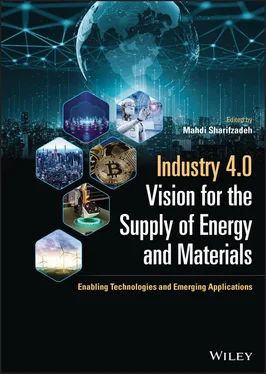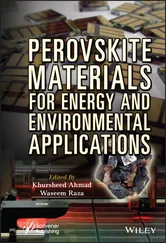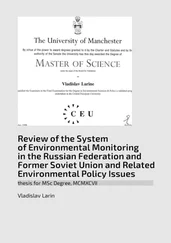1.4.3 Comparative Study of Wireless Standards for Industrial IoT
As noted already, various wireless technologies and standards provide connectivity in industrial systems. To choose the appropriate wireless technology for an industrial IoT application, different factors should be considered. Tables 1.1and 1.2present the main technical differences among the aforementioned technologies. The comparison considers the PHY and MAC layer features along with various performance measures that each technology aims to fulfill. Such comparative study would assist in specifying potential wireless technologies for an industrial application.
Table 1.1 Comparison of Wireless Technologies: Short-Range Technologies.
|
Zigbee |
Wireless HART |
ISAlOO.lla |
WIA-PA |
BLE |
Wi-Fi HaLow |
| Standard |
IEEE 802.15.4 |
PHY: IEEE 802.15.4 MAC: HART |
IEEE 802.15.4 |
IEEE 802.15.4 |
IEEE 802.15.1 |
IEEE 802.11.ah |
| Frequency band |
2.4 GHz |
2.4 GHz |
2.4 GHz |
2.4 GHz |
2.4 GHz |
Sub-lGHz |
| Number of |
16 |
16 |
16 |
16 |
40 5 |
7 6 |
| Channels |
|
|
|
|
|
|
| Topology |
Star, Tree, Mesh |
Star, Mesh |
Star, Mesh, Star-Mesh |
Hybrid Star-Mesh |
P2P, Star, Mesh 7 |
Star, Tree |
| Spreading |
DSSS |
DSSS, FHSS |
DSSS, FHSS |
DSSS |
FHSS |
MIMO-OFDM |
| MAC channel access |
GTS, CSMA; Time slot is flexible |
TSMP (TDMA, CSMA); Time slot of 10 ms |
TDMA, CSMA; Time slot of 10–12 ms |
TDMA, CSMA and FDMA; Time slot is configurable |
TDMA |
Hybrid EDCA/DCF |
| Channel bandwidth |
2 MHz |
2 MHz |
2 MHz |
20 MHz |
2 MHz 8 |
l/2/4/8/16 MHz |
| Range |
10–100 m |
<600 m |
<600 m (100 m 9) |
l–100 m |
<100 m (<300 m 7) |
90 m-l km |
| Data rate |
<250 Kbps |
<250 Kbps |
<250 Kbps |
<250 Kbps |
< 1 Mbps (0.125/ l/2 Mbps 7) |
0.15-78Mbps 10 |
| Nodes per network |
64,000 |
Hundreds per AP |
Thousands per gateway |
100 |
Piconet: 7 |
8192 |
| Power profile |
~ 3 years |
4–10 years |
6 years |
1 year |
1 year |
~1.5–13 years |
| Latency |
Enumeration 30 ms |
>10 ms |
> 100 ms |
>10 ms |
>6 ms |
>5 ms |
| Encryption |
128-bit AES |
128-bit AES |
128-bit AES |
128-bit AES |
128-bit AES |
WPA |
Table 1.2 Comparison of Wireless Technologies: Long-Range Technologies.
|
NB-IoT |
LTE-M |
LoRa/LoRaWAN |
| Standard |
3GPP Rel.13 (planned) |
3GPP Rel.13 (planned) |
LoRa-Alliance (De-facto Standard) |
| Frequency band |
Licensed LTE band |
Licensed LTE band |
Unlicensed sub-GHz 11 |
| Modulation |
LTE-based OFDMA(DL) & SC-FDMA(UL) |
LTE-based OFDMA(DL) & SC-FDMA(UL) |
Proprietary CSS |
| Spreading |
FDD/TDD |
FDD |
FHSS(ALOHA) |
| bidirectional |
Yes/Half-duplex |
Yes/Half-duplex |
Yes/Half-duplex |
| Maximum payload length |
256 bytes |
1600 bytes |
243 bytes |
| Maximum coupling loss (MCL) |
155.7 dB |
165 dB |
169 dB |
| Channel bandwidth |
1.4–20 MHz |
180/200 KHz |
125/250/500 KHz |
| Data rate |
DL: 300 Kbps; UL: 375 Kbps 12 |
DL: 200–300 Kbps; UL: 144 Kbps |
22 bps–50 Kbps 13 |
| Range |
11 Km |
1 Km(urban), 11 Km(rural) |
2 Km(urban),15 Km(rural) |
| Latency |
10 ms–4 s |
1.4–10 s (UL: < 10 s) |
Not Guaranteed |
| Nodes per network |
300–1500 per cell |
~ 52000 per cell |
200 per gateway 14 |
| Mobility |
Connected mobility with some limitation (inter frequency handover) |
No connected mobility (only idle mode reselection) |
Better than NB-IoT |
| Energy efficiency |
>10 years battery life of devices |
> 10–20 years battery life of devices |
>10 years battery life of devices |
| Interference Immunity |
Low |
Low |
Very high |
| Encryption |
LTE encryption, 128/256-bit AES |
LTE encryption, 128/256-bit AES |
128-bit AES |
| Attack |
Active and passive Eavesdropping attacks, sniffing attacks, and DoS |
Active and passive Eavesdropping attacks, sniffing attacks, and DoS |
Replay attack, DoS, Eavesdropping, Bit-Flipping attack, and LoRa class B attacks [122] |
1.5 Cellular and Mobile Technologies
Section 1.4 elaborated on different wireless technologies and standards that serve a variety of industrial applications. However, these wireless technologies are not sufficient for industrial applications that utilize data-intensive machines. In this context, cellular and mobile networks open up new opportunities in industrial applications. Cellular networks are empowered with ubiquitous presence, reliable communication links, widespread coverage, and mobility. These characteristics enhance operations of local networks and tailor them precisely to industrial applications for better leveraging the potentials of Industry 4.0 [123].
Historically, the primary focus of cellular communication was human-centric communication. With the rapid development of embedded devices and smart equipment, new communication standards were introduced to focus not only on the connectivity of people but also on communications between devices and machines in IoT. In this context, MTC has been proposed as a compelling solution that offers connectivity for diverse growing smart services such as smart meters, remote patient monitoring, smart manufacturing, boat tracking, and other similar cases [124, 125]. Within the cellular context, MTC is usually known as machine-to-machine (M2M) communication [57]. We will use MTC and M2M interchangeably in this chapter.
The MTC landscape uses both wireless and fixed networks to provide Internet access for a number of diverse applications [126]. This leads to diverse network protocols and data formats that exhibits different behavior in MTC systems [127]. MTC suffers from some fundamental limitations such as low coverage, and limited scalability. Cellular systems such as 4G, LTE, and 5G could be recognized as alternative technologies that extensively support MTC networks.
In this section, we first focus on a review of the current status of MTC in 3GPP cellular standards. We shall subsequently review LTE, 4G, and 5G and their enhanced features for communication in industrial environments.
3GPP characterized MTC as a form of data communication between machines in an autonomous manner that does not necessarily require human intervention [128]. MTC denotes two communications scenarios: (1) communication between MTC devices and MTC servers (e.g., in utility smart metering); and (2) direct communication between MTC devices without intermediate server (e.g., IoT) [128]. Although MTC could utilize different types of radio access technologies [129], MTC solutions based on mobile access technologies are of vital importance because cellular MTC offers viable benefits such as mobility, roaming support, robustness against single point of failures, and immediate and reliable data delivery [126, 128]. Moreover, scalability and ease of deployment in cellular MTC can be accomplished via an untethered method. Cellular MTC also excels the ability of connecting devices to the core enterprise systems through a standardized application programming interface (API), in a scalable, real-time, and secure way.
Читать дальше












